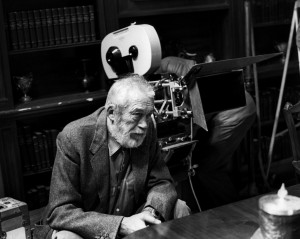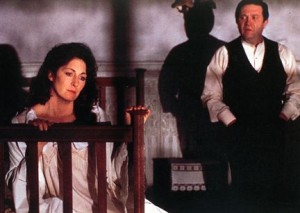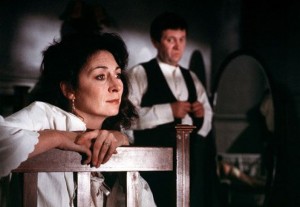From the July 8, 1988 Chicago Reader. — J.R.
JOHN HUSTON & THE DUBLINERS
** (Worth seeing)
Directed by Lilyan Sievernich.
The on-location production documentary, a movie chronicling the shooting of a movie, is a fairly recent phenomenon, although its equivalent in print has been around much longer. (For instance, Micheal MacLiammoir’s Put Money in Thy Purse, about Orson Welles’s Othello, and Lillian Ross’s Picture, about John Huston’s The Red Badge of Courage, were both published in 1952.) One usual difference between the written and the filmed reports is that the latter tend to be inside jobs financed by the producers of the features in question, and consequently are promotional in nature rather than critical: Chris Marker’s short feature about the making of Ran and Ron Mann’s documentary about the making of Legal Eagles are two recent examples, and Lilyan Sievernich’s hour-long account of John Huston shooting The Dead belongs in this category. Yet there are a few things about Sievernich’s film that make it rather special.
Huston was 82 and very close to dying when he made The Dead, and everyone connected with the film was acutely aware of it. He directed from a wheelchair, was hooked up to an oxygen machine for his emphysema, and generally viewed the actors on the set from a TV monitor. The knowledge that this would be Huston’s last film brought an unusual intimacy to the production, compounded by the fact that the film had been scripted by his son Tony and features as its female lead his daughter Anjelica, both of whom grew up in Ireland, which is the setting of The Dead. (Huston settled in Ireland in 1952 and became an Irish citizen in the mid-60s.) Sievernich, who is married to one of the coproducers of The Dead, was present on the set with her crew every day of the shooting, and, further enhancing the family atmosphere, many members of the cast and crew were also related by blood ties. Furthermore James Joyce, author of “The Dead,” had been one of Huston’s favorite writers ever since his mother brought him a contraband copy of Ulysses from Paris during the 20s. “It was probably the greatest experience that any book has ever given me,” he wrote in his 1980 autobiography, An Open Book; in the Sievernich documentary, he cites it as one of the reasons he moved to Ireland.
All these factors conspired to make The Dead the most personal of Huston’s films, even though it was basically filmed on a California soundstage. Yet paradoxically, Huston being Huston, its most personal quality is the director’s self-effacement, its impersonality. At the end of John Huston & the Dubliners, Sievernich interviews Huston about the meaning of The Dead, and he says, “The story is about a man being revealed to himself. And while we’re watching that happen, we’re revealed to ourselves” — a moment in the film that Huston goes on to describe as a “soul-shaking experience.” Sievernich gingerly asks him if his own situation makes him feel closer to that experience. “You mean, when I’m so close to dying myself,” Huston says with a cordial smile, gallantly assuring her that “you put it very gently.” Then he concludes, “I don’t think that makes very much difference.”
It may sound like a coy disavowal, yet given Huston’s peculiar attitude toward his work as a director, it’s probably close to the literal truth. This attitude also helps to explain why, although Huston was possibly a great man and certainly was a great man of the cinema, he wasn’t a great filmmaker, nor was he particularly interested in being one. His colorful life span might be regarded as the story of an adventurer rather than that of an artist; despite his lengthy involvements in many of the arts — painting, fiction, theater, and film — one often feels from his autobiography that it was the adventures that counted most for him.
Few critical reputations in film have known as many vicissitudes as Huston’s. Praised immoderately by James Agee in the pages of the Nation, Time, and Life in the 40s and early 50s, he was criticized no less excessively by the Young Turks of Cahiers du Cinéma in the later 50s, and by Andrew Sarris in Film Culture and the Village Voice in the 60s. Agee in 1950: “To put it conservatively, there is nobody under fifty at work in movies, here or abroad, who can excel Huston in talent, inventiveness, intransigence, achievement or promise.” François Truffaut: “The worst Hawks film is more interesting than the best of Huston.” Sarris in 1963: “Huston is virtually a forgotten man with a few actors’ classics behind him surviving as the ruins of a once-promising career.”
Rediscovered and applauded by some of his former adversaries (including Sarris) in the 70s with Fat City, The Man Who Would Be King, and Wise Blood, Huston then promptly shattered most of their auteurist hopes and expectations with his next three features — Phobia, Victory, and Annie, all of them unabashed commercial assignments to which he brought little interest or distinction. And then, finally, to confound all theories, he ended his career with three more “personal” (or personally impersonal) films, all carefully crafted and highly praised literary adaptations: Under the Volcano, Prizzi’s Honor, and The Dead.
Indeed, it might be said in retrospect that, barring only his three war documentaries — Report From the Aleutians (1943), San Pietro (1945), and Let There Be Light (1946) — the most ambitious and accomplished Huston films are nearly all adaptations of distinguished novels. The lineup is impressive: The Maltese Falcon (his first feature, 1941), The Treasure of the Sierra Madre (1948), The Asphalt Jungle (1950), The African Queen (1952), Moby Dick (1956), The Roots of Heaven (1958), Reflections in a Golden Eye (1967), A Walk With Love and Death (1969), Fat City (1972), Wise Blood (1979), Under the Volcano (1984), and Prizzi’s Honor (1985). Moreover, practically all of Huston’s remaining best films have a literary source of one kind or another: The Man Who Would Be King and The Dead, derived from two of his favorite short stories; Key Largo (1948) and The Night of the Iguana (1964), adapted from plays; The Bible (1965); Moulin Rouge (1953), directly inspired by a Pierre la Mure novel, followed by Beat the Devil (1954), whose source was a novel by Huston’s friend Claude Cockburn, writing under the name James Helvick; even The Misfits (1961) and Freud (1963), which can be described as conscientious adaptations of very literary scripts, by Arthur Miller and Jean-Paul Sartre, respectively.
It should be acknowledged, then, that the instability of Huston’s reputation has been due in part to the implications of his status as a literary adapter, and a relatively faithful one at that, at least by Hollywood standards. Eric Rohmer claimed in essence that the central flaw of Huston’s Moby Dick lay not so much in how it was done as in the fact that Huston decided to undertake it in the first place; much the same criticism could be leveled against Under the Volcano and The Dead. All three prose works are masterpieces so rich in their own medium that they defy translation into film without severe reductions and simplifications. Huston’s versions, as intelligent as they often are, are profoundly lacking in the personal investment and intensity that mark the sources, despite — or could it be because of? — his clear and unwavering reverence for them.
Another reason for the unevenness of Huston’s reputation may he his frequent willingness to take on projects for extraneous or simply perverse reasons; reportedly he made The African Queen so that he could hunt elephants, and apparently he made The Roots of Heaven because its quixotic hero launches a radical campaign against elephant hunters. Then there’s the seeming absence of a style or thematic consistency to bind together the extreme diversity of his work. A few critics have attempted to attach a style to Huston. Manny Farber tried to do so using painterly terms, claiming to find a “Huston trademark” consisting of “two unorthodox practices — the statically designed image (objects and figures locked into various pyramid designs) and the mobile handling of close three-figured shots.” One can also see some limited continuity in the unusual color schemes of Moulin Rouge, Moby Dick, and Reflections in a Golden Eye, even if the implications of this stylistic approach are decorative and superimposed, rather than dramatic reflections growing directly out of the stories. Other critics have concentrated on the individualist heroes of Huston’s films and/or the absurdist failures of their various enterprises. Despite these critics’ best efforts, though, the visual and thematic patterns in Huston’s oeuvre remain at best intermittent, never taking on the obsessive consistency of a Hawks, a Welles, or a Sternberg. If Huston can be described as an auteur at all, he is certainly the antiauteurist auteur par excellence.
It could be argued that the growing strength of Huston’s image in world cinema has as much to do with his presence as an actor as it does with his less consistent record as a writer and director. To a large extent, his charismatic actor’s identity — beginning in earnest with The Cardinal in 1963 after small roles and offscreen narration in some of his own films, and continuing in such films as Myra Breckenridge, Chinatown, The Wind and the Lion, and Winter Kills, among many others — softened the more cynical and defeatist side of his personality that was perceived in the films that he directed. However bleak his view of the world and of human nature, the twinkle in his eye made it all seem less severe.
It seems somehow significant that the first and last shots in the Huston oeuvre — the beginning of The Maltese Falcon (a shot of the Golden Gate Bridge) and the end of The Dead (snow falling in rural Ireland) — were both shot by second units. Even at his most engaged, as he was on these two films, Huston focused more of his undeniable craft on writing and casting — and working with writers and actors — than on mise en scène. He seems to make this point himself in Sievernich’s documentary when he says, “I have no style that I’m aware of,” and stresses that casting is everything. Perhaps what he excelled at most was fluid story telling — not in the manner of a Hawks or Hitchcock, for whom story telling was largely either the exorcism of personal demons or an emphasis on character and atmosphere, but rather in the sense that he translated literary works that he loved and respected into precise images. They were not invariably or necessarily his own images, but they did suit his taste.
One thing that helps to give some shape and coherence to Huston’s varied life and career (including his atheism — a key factor that distinguishes his remarkable Wise Blood from Flannery O’Connor’s), is to view him as an existentialist. Apart from the fact that he directed the first U.S. stage production of No Exit and commissioned the Freud screenplay from Sartre, he was clearly a man who loved to gamble and take risks, valuing acts and gestures over things and essences, despite — or, again, was it because of? — the apparent certainty that they were taking place over a metaphysical void. The grim laughter heard at the end of The Treasure of the Sierra Madre and Beat the Devil, and the serene, unsentimental confrontation of untranscendent death at the end of Fat City, Wise Blood, Under the Volcano, and The Dead, reflect an unblinking yet unpretentious gaze at the specter of failure as a condition of life.
This is not an attitude, however, that precludes reverence, at least for the things that Huston believed in. Reverence is certainly what he gets in John Huston & the Dubliners, and under the circumstances he seems to deserve it. The film shows us a fair sampling of his work with actors — more than we usually get in production documentaries — and whether he’s instructing a stage actress in how to be less theatrical or telling his daughter to turn her head slightly, there’s a courtly gentleness in his manner that invariably seems to produce the effects that he wants. The fact that he’s dying, and facing the fact that he’s dying, and meanwhile making a movie about facing oneself and about dying, may all finally be coincidental, as well as secondary: “I don’t think that makes very much difference.”




